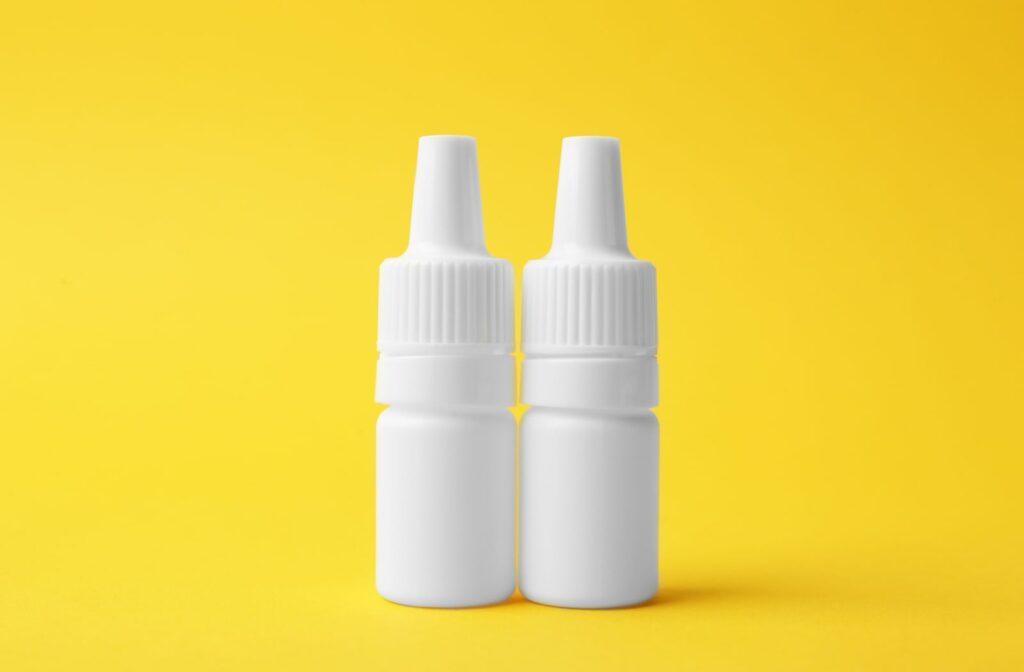Eye drops are an essential part of our daily routine for many of us. They can often help relieve the symptoms of dryness, allergies, and other eye problems. But what do you do when the expiration date on your eye drops has passed?
Expired eye drops can be less effective or even contaminated, so using them can be dangerous to your eye health. If your optometrist recommends using eye drops, make sure they’re fresh by watching their expiration date.
Using Eye Drops
Eye drops are one of the most common and effective ways to treat and prevent various eye problems. Whether you’re looking for hydration or need medication for eye diseases, a bottle of eye drops in your pocket can help when needed.
Common conditions treated with eye drops include:
- Dry eye
- Eye allergies
- Red eyes
- Glaucoma
- Eye infections
Not all eye drops are compatible with contact lenses. Before using eye drops of any kind, check with your optometrist that they’re safe for contact lens wearers. Some eye drops may contain ingredients that can damage or cloud your lenses, while others may cause irritation or discomfort.
Understanding the Expiration Date
The expiration date could be the last day the active ingredients in the eye drops are stable. After the expiration date, the formula starts to break down, which may cause a decrease in effectiveness. This is true for both over-the-counter and prescription eyedrops.
If you find a bottle at the back of your medicine cabinet or the bottom of your purse, check the date on the bottle or package. If you can’t find one, it’s usually better to be safe than sorry. Toss the drops and get yourself a fresh pack.
Once you break the seal, you only have a limited time to use them at full potency. This time depends on the type of eye drops. For example, preservative-free drops are typically good for 24 hours, while other types could last up to 3 months. You should also discard any eye drop bottles that appear cloudy or have visible particles.
Is Using Expired Eye Drops Dangerous?
First and foremost, let’s make one thing clear: expired eye drops may not always be dangerous, but they could be less effective or even completely useless. Depending on the type and brand, eye drops have a shelf life of about 1–2 years from the manufacturing date.
After expiration, the active ingredients in the eye drops can break down and lose their potency, resulting in less effective treatment, or even no treatment at all. So, if you’ve been using expired eye drops for your red eyes or allergies, it’s possible you’re not getting any relief. However, if you’re using eye drops for a severe condition such as glaucoma, ineffective treatment could mean irreversible damage.
One outcome for expired eye drops is they simply don’t work, but another critical factor to consider is the possibility of contamination. Eye drops can be preservative-free or contain very mild preservatives to avoid causing eye irritation.
However, after the expiration date, the preservatives can break down and fail to keep the eye drops free of harmful bacteria or fungi growth. Inevitably, using contaminated eye drops can lead to infections, especially for people with chronic conditions requiring regular eye drop use.
Storing Your Eye Drops Properly
Knowing how to store eye drops is just as critical as using them. Improper storage can lead to a plethora of complications and reduce their effectiveness, even if they aren’t expired. Always follow the manufacturer’s recommendations and check labels carefully. If you’re ever unsure, contact your optometrist. We’re here to help!
Here are some tips for storing and using eye drops properly:
- Check the product label: Different eye drops may have different shelf lives once opened, which can vary from product to product. The instructions can also tell you whether or not you need to refrigerate your eye drops.
- Refrigerate, if necessary: Some eye drop solutions need to stay at temperatures colder than room temperature. You’ll usually have to do this after opening them, as it can help slow degradation.
- Store in a cool, dry location: In most instances, you can keep eye drops at room temperature. Take care that they’re not exposed to direct sunlight or major temperature fluctuations during the course of the day. Where possible, store eye drops in a cool, dark place, such as a medicine cabinet or on a shelf in the bedroom.
- Proper eye drop hygiene: Wash your hands thoroughly before handling eye drops. Avoid touching the dropper or the tip of the bottle to keep them sterile. Wipe the tip with a clean tissue before putting the cap back on and avoid sharing eye drop containers with anyone else.
- Pay attention to expiration dates: As we’ve discussed, eye drops can expire. The date should be printed on the label or the bottle itself. Discarding eye drops that have outlived their shelf life helps keep you safe from contamination while also helping the solution stay at full potency.
Eye Care You Can Trust
Expired eye drops aren’t always directly harmful, but that doesn’t mean they’re safe to use. Even if they aren’t contaminated and ready to cause painful eye infections, they’re likely not as effective and won’t provide the relief you need. It’s not worth the risk. Toss your expired drops and get yourself a new bottle, instead!
If you’re ever unsure if your eye drops are safe, or if it feels like they’re not working at their full power, the Eye Effects team can help determine the problem. For dry eyes, prescription eye drops, and more, we have the know-how and passion for bringing comfort to your vision.
Feel the effects of personalized eye care and book your eye exam today!


